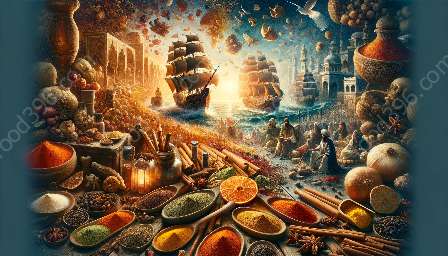Spices have played a significant role in human history, particularly in the Middle Ages when the spice trade flourished. This article explores the origins, routes, and impact of spice trade on food culture and history. It delves into the historical significance of spices, their trade, and their enduring influence on global cuisine.
The History of Spices and Their Trade
Spices have been valued for centuries for their aromatic, medicinal, and preservative qualities. The trade of spices dates back to ancient civilizations, with the Middle Ages witnessing a surge in their demand and consequently, the growth of extensive trade networks.
Origins of Spice Trade
The spice trade has ancient origins, with the earliest records dating back to ancient Egypt and Mesopotamia. Spices were highly prized commodities, often used in religious rituals, embalming practices, and for culinary purposes.
Routes of Spice Trade
During the Middle Ages, the spice trade was dominated by a few powerful empires and civilizations such as the Byzantine Empire, the Islamic Caliphates, and the Mongol Empire. Spice routes connected the Mediterranean, Middle East, and Asia, with renowned paths such as the Silk Road and the Spice Route enabling the exchange of spices and other valuable goods across vast distances.
Impact of Spice Trade on Food Culture and History
The introduction of new spices had a profound impact on the culinary practices and food culture of the Middle Ages and beyond. Spices such as cinnamon, pepper, cloves, and nutmeg transformed the flavors and aromas of medieval cuisine, leading to the development of sophisticated and highly prized dishes.
Medicinal and Culinary Uses
In addition to enhancing the taste of food, spices were also valued for their medicinal properties. They were believed to have therapeutic effects and were used to alleviate various ailments, thus influencing the development of medical traditions and practices.
Cultural Exchange and Globalization
The spice trade facilitated cultural exchange and globalization in the Middle Ages, as it brought together people from diverse regions, fostering the exchange of knowledge, traditions, and technologies.
Food Culture and History
Spices became symbols of wealth, power, and prestige, and their availability and use were often intertwined with social status and economic prosperity. The demand for spices led to fierce competition, geopolitical conflicts, and the rise of powerful trading empires.
Legacy of Spice Trade
The legacy of the spice trade in the Middle Ages is evident in modern culinary practices and food culture. Spices continue to be essential ingredients in global cuisines, and their historical significance is commemorated in culinary traditions, festivals, and the enduring appeal of exotic flavors.
Sustainability and Conservation
The history of spice trade also raises important issues of sustainability and conservation, as the demand for spices has led to environmental challenges and the need to protect the natural habitats of spice-producing plants.
Conclusion
The spice trade in the Middle Ages was a captivating era in history, marked by the allure of exotic spices, extensive trade networks, and transformative impacts on food culture and history. As we savor the flavors of spices in our modern dishes, it is essential to recognize their historical journey and the enduring legacy of the spice trade.

